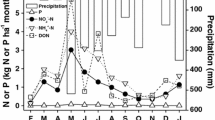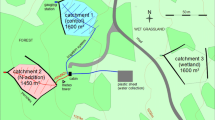Abstract
Atmospheric nutrient deposition has contributed to widespread changes in sensitive seminatural ecosystems throughout Europe. For an understanding of underlying processes it is important to quantify input–output flows in relation to ongoing atmospheric inputs and current management strategies. In this study we quantified losses of N, P, Ca, Mg, and K via leaching in heathland ecosystems (Lüneburger Heide, NW Germany) as a function of current deposition rates and different management measures (mowing, prescribed burning, choppering, sod-cutting) which aim to prevent shrub and tree encroachment. Leaching was only moderately related to atmospheric input rates, indicating that leaching was mostly affected by internal turnover processes. Leaching significantly increased for most of the nutrients after the application of management measures, particularly in the choppered and sod-cut plots. However, atmospheric nutrient inputs exceeded leaching outputs for most of the nutrients, even in the plots subjected to management. Despite high deposition rates (20–25 kg N ha−1 year−1), retention of atmospheric N input ranged between 74% and 92% in the control plots. In the treated plots, N retention decreased to 59–80%. However, in the study area mean N leaching in the controls has almost doubled since 1980 and currently amounts to 3.7 kg ha−1 year−1, indicating an early stage of N saturation. Our study provides evidence that leaching did not compensate for atmospheric nutrient deposition, particularly as regards N. Management, thus, will be an indispensable tool for the maintenance of the low-nutrient status as a prerequisite for the long-term preservation of heathland ecosystems.



Similar content being viewed by others

References
Aerts R, Chapin FS (2000) The mineral nutrition of wild plants revisited: a re-evaluation of processes and patterns. Adv Ecol Res 30:1–67
Anderson JM, Hetherington SL (1999) Temperature, nitrogen availability and mixture effects on the decomposition of heather (Calluna vulgaris (L.)Hull) and bracken (Pteridium aquilinum (L.)Kuhn) litters. Funct Ecol 13:116–124
Bakema AH, Meijers R, Aerts R, Berendse F, Heil GW (1994) HEATHSOL: a heathland competition model. National Institute of Public Health and Environmental Protection Report 259102009
Barker CG, Power SA, Bell JNB, Orme CDL (2004) Effects of habitat management on heathland response to atmospheric nitrogen deposition. Biol Conserv 120:41–52
Berendse F (1990) Organic matter accumulation and nitrogen mineralization during secondary succession in heathland ecosystems. J Ecol 78:413–427
Bobbink R, Heil GW, Raessen MBAG (1992) Atmospheric deposition and canopy exchange processes in heathland ecosystems. Environ Pollut 75:29–37
Bobbink R, Ashmore M, Braun S, Fluckiger W, van den Wyngaert IJJ (2003) Empirical nitrogen critical loads for natural and semi-natural ecosystems: 2002 update. In: Achermann B, Bobbink R (eds) Empirical critical loads for nitrogen. Environmental Documentation No. 164. Swiss Agency for the Environment, Forest and Landscape, pp 43–170
Brady NC, Weil RR (2002) The nature and properties of soils. Prentice Hall, London
Britton AJ, Pakeman RJ, Carey PD, Marrs RH (2001) Impacts of climate, management and nitrogen deposition on the dynamics of lowland heathland. J Veg Sci 12:797–806
Chapman PJ, Williams BL, Hawkins A (2001) Influence of temperature and vegetation cover on soluble inorganic and organic nitrogen in a spodosol. Soil Biol Biochem 33:1113–1121
Chen XY, Mulder J (2007) Indicators for nitrogen status and leaching in subtropical forest ecosystems, South China. Biogeochemistry 82:165–180
Diemont WH (1996) Survival of Dutch heathlands. IBN Scientific Contribution 1, Wageningen
Dise NB, Matzner E, Forsius M (1998a) Evaluation of organic horizon C:N ratio as an indicator of nitrate leaching in conifer forests across Europe. Environ Pollut 102:453–456
Dise NB, Matzner E, Gundersen P (1998b) Synthesis of nitrogen pools and fluxes from European forest ecosystems. Water Air Soil Pollut 105:143–154
Dorland E, van den Berg LJL, van den Berg AJ, Vermeer M, Roelofs JGM, Bobbink R (2004) The effects of sod cutting and additional liming on potential net nitrification in heathland soils. Plant Soil 265: 267–277
Erisman JW, de Vries W (2000) Nitrogen deposition and effects on European forests. Environ Rev 8:65–93
Evans CD, Reynolds B, Jenkins A, Helliwell RC, Curtis CJ, Goodale CL, Ferrier RC, Emmett BA, Pilkington MG, Caporn SJM, Carroll JA, Norris D, Davies J, Coull MC (2006a) Evidence that soil carbon pool determines susceptibility of semi-natural ecosystems to elevated nitrogen leaching. Ecosystems 9:453–462
Evans CD, Caporn SJM, Carroll JA, Pilkington MG, Wilson DB, Ray N, Cresswell N (2006b) Modelling nitrogen saturation and carbon accumulation in heathland soils under elevated nitrogen deposition. Environ Pollut 143:468–478
Forgeard F (1990) Development, growth and species richness on Brittany heathlands after fire. Acta Oecologia 11:191–213
Gauger T, Köble R, Anshelm F (2000) Kritische Luftschadstoff-Konzentrationen und Eintragsraten sowie ihre Überschreitung für Wald und Agrarökosysteme sowie naturnahe waldfreie Ökosysteme. Studie im Auftrag des Umweltbundesamtes Berlin. Institut für Navigation der Universität Stuttgart. Bericht Nr. 29785079, Berlin
Gimingham CH, Hobbs RJ, Mallik AU (1981) Community dynamics in relation to management of heathland vegetation in Scotland. Vegetatio 46:149–155
Grasshoff H, Ehrhardt M, Kremling K (1983) Methods of seawater analysis. Verlag Chemie, Weinheim
Hansen B, Nielsen KE (1998) Comparison of acidic deposition to semi-natural ecosystems in Denmark-Coastal heath, inland heath and oak wood – Forest decline in West Germany. Atmos Environ 32:1075–1086
Härdtle W, Niemeyer M, Niemeyer T, Assmann T, Fottner S (2006) Can management compensate for atmospheric nutrient deposition in heathland ecosystems? J Appl Ecol 43:759–769
Härdtle W, von Oheimb G, Friedel A, Meyer H, Westphal C (2004) Relationship between pH-values and nutrient availability in forest soils – the consequences for the use of ecograms in forest ecology. Flora 199:134–142
Heil GW, Bobbink R (1993) “Calluna”, a simulation model for evaluation of impacts of atmospheric nitrogen deposition on dry heathlands. Ecol Model 68:161–182
Herrmann M, Pust J, Pott R (2005) Leaching of nitrate and ammonium in heathland and forest ecosystems in Northwest Germany under the influence of enhanced nitrogen deposition. Plant Soil 273:129–137
Kaste Ø, Skjelkvåle BL (2002) Nitrogen dynamics in runoff from two small heathland catchments representing opposite extremes with respect to climate and N deposition in Norway. Hydrol Earth Syst Sci 6:351–362
Kirkham FW (2001) Nitrogen uptake and nutrient limitation in six hill moorland species in relation to atmospheric nitrogen deposition in England and Wales. J Ecol 89:1041–1053
Kristensen HL (2001) High immobilization of NH4 + in Danish heath soil related to succession, soil and nutrients: implications for critical loads of N. Water Air Soil Pollut Focus 1:211–230
Mallik AU, FitzPatrick EA (1996) Thin section studies of Calluna heathland soils subject to prescribed burning. Soil Use Manage 12:143–149
Manning P, Putwain PD, Webb NR (2006) The role of soil phosphorus sorption characteristics in the functioning and stability of lowland heath ecosystems. Biogeochemistry 81:205–217
Marcos E, Calvo L, Luis-Calabuig E (2003) Effects of fertilization and cutting on the chemical composition of vegetation and soils of mountain heathlands in Spain. J Veg Sci 14:417–424
Matzner E, Ulrich B (1980) The transfer of chemical elements within a heath ecosystem (Calluna vulgaris) in northwest Germany. Z Pflanz Bodenkunde 143:666–678
Mitchell RJ, Auld MHD, Hughes JM, Marrs RH (2000) Estimates of nutrient removal during heathland restoration on successional sites in Dorset, southern England. Biol Conserv 95:233–246
Mohamed A, Härdtle W, Jirjahn B, Niemeyer T, von Oheimb G (2006) Effects of prescribed burning on plant available nutrients in dry heathland ecosystems. Plant Ecol 189:279–289
Nielsen KE, Ladekarl UL, Nørnberg P (1999) Dynamic soil processes on heathland due to changes in vegetation to oak and Sitka spruce. For Ecol Manage 114:107–116
Nielsen KE, Hansen B, Ladekarl UL, Nørnberg P (2000) Effects of N-deposition on ion trapping by B-horizons of Danish heathlands. Plant Soil 223:265–276
Niemeyer M, Niemeyer T, Fottner S, Härdtle W, Mohamed A (2007) Impact of sod-cutting and choppering on nutrient budgets of dry heathlands. Biol Conserv 134: 344–353
Niemeyer T, Niemeyer M, Mohamed A, Fottner S, Härdtle W (2005) Impact of prescribed burning on the nutrient balance of heathlands with particular reference to nitrogen and phosphorus. Appl Veg Sci 8:183–192
Nilsen LS, Johansen L, Velle LG (2005) Early stages of Calluna vulgaris regeneration after burning of coastal heath in central Norway. Appl Veg Sci 8:57–64
Olff H, Pegtel DM (1994) Characterisation of the type and extent of nutrient limitation in grassland vegetation using a bioassay with intact sods. Plant Soil 163:217–224
Pilkington MG, Caporn SJM, Carroll JA, Cresswell N, Lee JA, Emmett BA, Johnson D (2005) Effects of increased deposition of atmospheric nitrogen on an upland moor: leaching of N species and soil solution chemistry. Environ Pollut 135:29–40
Power SA, Ashmore MR, Cousins DA (1998) Impacts and fate of experimentally enhanced nitrogen deposition on a British lowland heath. Environ Pollut 102 S1:27–34
Power SA, Barker CG, Allchin EA, Ashmore MR, Bell JNB (2001) Habitat management: a tool to modify ecosystem impacts of nitrogen deposition? Sci World 1:714–721
Power SA, Green ER, Barker CG, Bell JNB, Ashmore MR (2006) Ecosystem recovery: heathland response to a reduction in nitrogen deposition. Global Change Biol 12:1241–1252
Rode MW (1999a) Influence of forest growth on former heathland on nutrient input and its consequences for nutrition and management of heath and forest. For Ecol Manage 114:31–43
Rode MW (1999b) The interaction between organic layer and forest growth and forest development on former heathland. For Ecol Manage 114:117–127
Schmidt IK, Tietema A, Williams D, Gundersen P, Beier C, Emmett BA, Estiarte M (2004) Soil solution chemistry and element fluxes in three European heathlands and their responses to warming and drought. Ecosystems 7:638–649
Sedláková I, Chytrý M (1999) Regeneration patterns in a Central European dry heathland: effects of burning, sod-cutting and cutting. Plant Ecol 143:77–87
Steubing L, Fangmeier A (1992) Pflanzenökologisches Praktikum. Parey Verlag, Berlin
Sverdrup H, Thelin G, Robles M, Stjernquist I, Sorensen J (2006) Assessing nutrient sustainability of forest production for different tree species considering Ca, Mg, K, N and P at Bjornstorp Estate, Sweden. Biogeochemistry 81:219–238
Terry AC, Ashmore MR, Power SA, Allchin EA (2004) Modelling the impacts of atmospheric nitrogen deposition on Calluna-dominated ecosystems in the UK. J Appl Ecol 41:897–909
Uren SC, Ainsworth N, Power SA, Cousins DA, Huxedurp LM, Ashmore MR (1997) Long-term effects of ammonium sulphate on Calluna vulgaris. J Appl Ecol 34:208–216
van Diggelen R, Marrs RH (2003) Restoring plant communities – Introduction. Appl Veg Sci 6:106–110
Verhoeven JTA, Koerselman W, Meuleman AFM (1996) Nitrogen- or phosphorus-limited growth in herbaceous, wet vegetation: relations with atmospheric inputs and management regimes. Trends Ecol Evol 11:494–497
Webb NR (1998) The traditional management of European heathland. J Appl Ecol 35:987–990
Werger MJA, Prentice IC, Helsper HPH (1985) The effect of sod-cutting to different depth on Calluna heathland regeneration. J Environ Manage 20:181–188
White CC, Dawod AM, Cresser MS (1996) Nitrogen accumulation in surface horizons of moorland podzols: evidence from a Scottish survey. Sci Total Environ 184:229–237
Acknowledgements
This ecosystem research project was funded by the German Ministry for Education and Research. We acknowledge the support of the Alfred Toepfer Academy for both the field experiments and the project coordination.
Author information
Authors and Affiliations
Corresponding author
Rights and permissions
About this article
Cite this article
Härdtle, W., von Oheimb, G., Niemeyer, M. et al. Nutrient leaching in dry heathland ecosystems: effects of atmospheric deposition and management. Biogeochemistry 86, 201–215 (2007). https://doi.org/10.1007/s10533-007-9156-5
Received:
Accepted:
Published:
Issue Date:
DOI: https://doi.org/10.1007/s10533-007-9156-5



